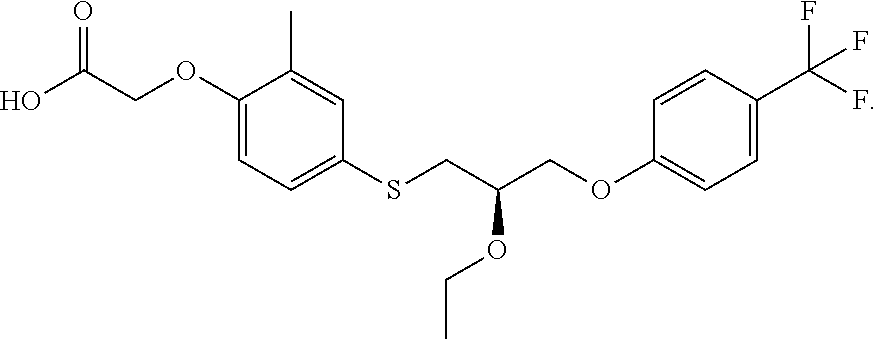Treatment of Severe Hyperlipidemia
a hyperlipidemia and treatment technology, applied in the field of severe hyperlipidemia, can solve the problems of low ldl receptor activity, general response to such therapies, and reduced ldl receptor density, so as to improve other lipid parameters, improve the effect of ldl-c, and reduce the ldl-c clearan
- Summary
- Abstract
- Description
- Claims
- Application Information
AI Technical Summary
Benefits of technology
Problems solved by technology
Method used
Image
Examples
example 1
Dose Escalation Study with MBX-8025 and Evolocumab in HoFH
[0058]Subjects with HoFH (diagnosed either by genetic testing or by an untreated LDL-C >500 mg / dL and early appearance of xanthoma or LDL-C levels consistent with HeFH in both parents), on maximally-tolerated lipid-lowering therapy (one or more of a statin, a cholesterol absorption inhibitor, and a bile acid sequestrant) and evolocumab at 420 mg once monthly, are treated with MBX-8025 L-lysine dihydrate salt at a dose of 50, 100, or 200 mg / day (as MBX-8025 free acid), escalating every 4 weeks. The subjects are instructed to maintain a low-fat diet (<20% energy from fat) and to take dietary supplements that provide approximately 400 IU vitamin E, 210 mg α-linolenic acid, 200 mg linoleic acid, 110 mg eicosapentenoic acid, and 80 mg docosahexaenoic acid per day; and are permitted their usual other medications. The subjects are assessed before the study, and at intervals during the study, such as every 1, 2, and 4 weeks after the...
example 2
Dose Escalation Study with MBX-8025 and Evolocumab in HeFH
[0061]Subjects with HeFH, on maximally-tolerated lipid-lowering therapy (one or more of a statin, a cholesterol absorption inhibitor, and a bile acid sequestrant) and evolocumab at either 140 mg every 2 weeks or 420 mg once monthly, are treated with MBX-8025 L-lysine dihydrate salt at a dose of 50, 100, or 200 mg / day (as MBX-8025 free acid), escalating every 4 weeks. The subjects are instructed to maintain a low-fat diet (<20% energy from fat) and to take dietary supplements that provide approximately 400 IU vitamin E, 210 mg α-linolenic acid, 200 mg linoleic acid, 110 mg eicosapentenoic acid, and 80 mg docosahexaenoic acid per day; and are permitted their usual other medications. The subjects are assessed before the study, and at intervals during the study, such as every 1, 2, and 4 weeks after the start of a new dose and 4 weeks after the last dose of the combination therapy, for safety and pharmacodynamic evaluations. MRIs...
example 3
Dose Escalation Study with MBX-8025 and Evolocumab in Primary Hyperlipidemia with Clinical Atherosclerotic Cardiovascular Disease
[0064]Subjects with primary hyperlipidemia and clinical atherosclerotic cardiovascular disease, on maximally-tolerated lipid-lowering therapy and evolocumab at either 140 mg every 2 weeks or 420 mg once monthly, are treated with MBX-8025 L-lysine dihydrate salt at a dose of 50, 100, or 200 mg / day (as MBX-8025 free acid), escalating every 4 weeks. The subjects are permitted their usual other medications. The subjects are assessed before the study, and at intervals during the study, such as every 1, 2, and 4 weeks after the start of a new dose and 4 weeks after the last dose of the combination therapy, for safety and pharmacodynamic evaluations. MRIs of the subjects' livers are taken after 4 weeks at each dose, and 4 weeks after study completion, to determine hepatic fat. At each visit, after a 12-hour fast, blood is drawn and urine collected; and a standard...
PUM
| Property | Measurement | Unit |
|---|---|---|
| concentration | aaaaa | aaaaa |
| particle size | aaaaa | aaaaa |
| particle size | aaaaa | aaaaa |
Abstract
Description
Claims
Application Information
 Login to View More
Login to View More - R&D
- Intellectual Property
- Life Sciences
- Materials
- Tech Scout
- Unparalleled Data Quality
- Higher Quality Content
- 60% Fewer Hallucinations
Browse by: Latest US Patents, China's latest patents, Technical Efficacy Thesaurus, Application Domain, Technology Topic, Popular Technical Reports.
© 2025 PatSnap. All rights reserved.Legal|Privacy policy|Modern Slavery Act Transparency Statement|Sitemap|About US| Contact US: help@patsnap.com

